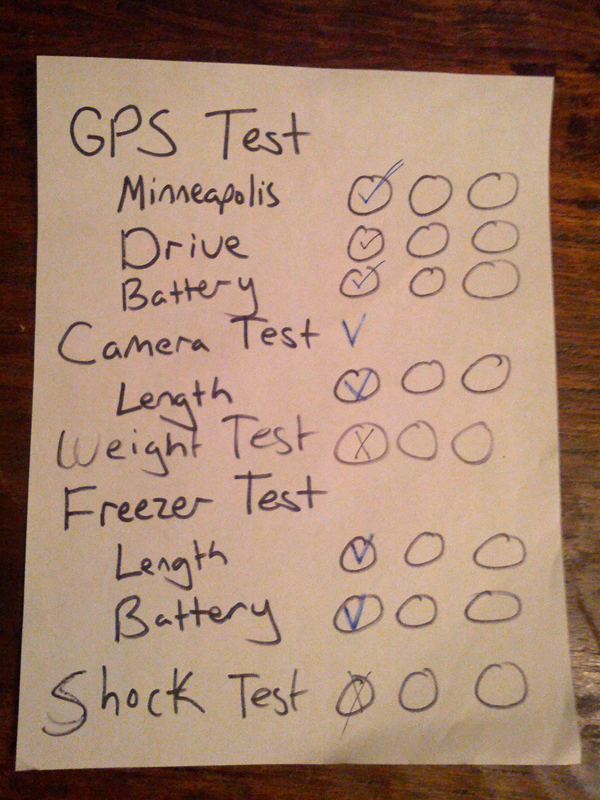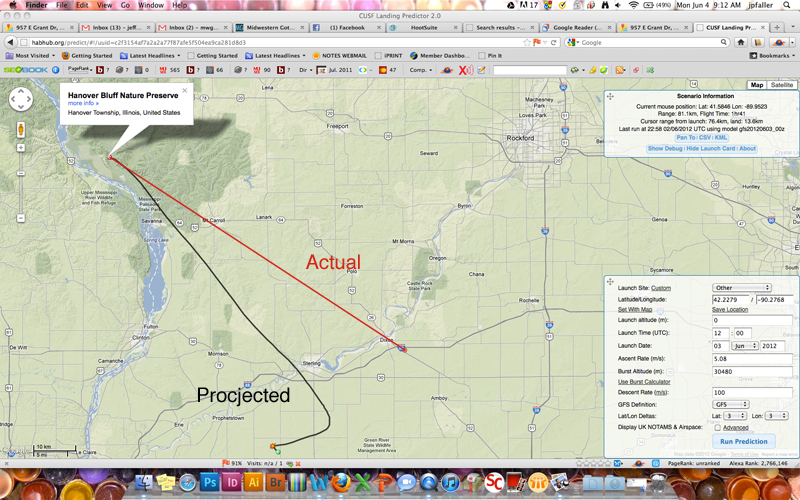Sending a Weather Balloon To (Almost) Near Space
Every summer, I let Miles pick a project to tackle. Year 1 was finding a dinosaur fossil. Year 2 was making a movie (totally fizzled out).
Want a shortcut to the video of the flight?
This year, he said he wanted to send a rocket to outer space. I thought for sure it’d be a bust too. After all, I don’t have the cash to pay a bunch of rocket scientists. And even if I did, you can bet I don’t have the guts to pull off something like these guys did.
But then I remembered a video I’d seen awhile back of some guys who sent an iPhone 4s into space. They used a weather balloon – so why couldn’t we?
How We Did It
First, and most importantly, is it legal? Yep, the FAA allows unmanned balloons to be sent up by civilians. You need to file a flight plan and make a few phone calls during the launch process at a few different points (launch, when the balloon goes above 60,000 feet, when it comes back below 60,000 feet.)
With that settled, I let Miles draw up the design for the rig. It was actually pretty close to what we ended up building.
I did a refined sketch, and then we set about making the thing. I knew we’d need to tweak things along the way as we figured it out.

These were some of his sketches that didn’t make the cut.

The Balloon
It was actually kind of hard to find a weather balloon – there were a few on eBay and one listed on Amazon, but other than that, what I was uncovering wouldn’t really work for us. I settled on the Amazon balloon, which would hopefully make it to 70,000 feet, past the 65,000 foot border that marks near space.
We’d fill the balloon with helium (I’m not brave enough to do hydrogen. And I have no idea why anyone would be) to a diameter of 6 feet. As it rises, the gas inside expands until the balloon reaches its bursting diameter of 20 feet.
After the fact, I found a company that manufactures high altitude balloons. They’re more rugged and will travel higher, but a touch more expensive. I ended up buying another one for a backup balloon, just in case something went awry.
The Rig
With the amount of helium we needed to put in the balloon, we’d get about 5lbs of lift. So that meant whatever we built had to be lighter than that to even get off the ground. We also had to solve for a myriad of other problems:
- Can we capture pictures or a video?
- Can we find it when it comes back down?
- Will the equipment survive the return impact?
- Will the batteries stay warm for the entire journey?
- Will it reflect a radar signal?
- How do we slow the descent?
At the end of the day, what we built was basically a Styrofoam cooler, attached to the balloon with 10lbs test string. Here’s our grocery list:
- Styrofoam cooler
- 10lbs test string
- Tupperware container + extra lid
- 12 gauge wire
- Zip ties
- 24” parachute
- Radar reflector
- Duct Tape
- Styrofoam padding (for seat cushions)
- GoPro HD Hero Camera
- Droid Eris Android Phone
- Hand warmers
Slap it all together, and the whole thing weighed about 1.5 lbs, which was awesome. We painted the cooler bright red and wrote our phone number all over the outside with the promise of a $50 reward if someone else happened to find it.
The Tests
I suppose we could have sent it straight up, but I wanted to make sure everything would work as planned to iron out the kinks. This is our test list.

The two big tests were to make sure our GPS tracking software (Accutracking and Google Latitude) would:
- Accurately locate the phone
- Give at least three hours of battery life
- Reacquire satellites if a signal was lost
One test was with just the phone, in an area with little to no cell signal, trying to mimic not having a 3g signal in space. It only ate half the battery in 4 hours, so I knew we were good.
The second was putting the whole rig together, starting up the camera and the battery, and shoving it in the freezer to mimic (or as close as possible, the -60F temperatures of near space. We passed this test too with flying colors, so we were ready to go!
The Launch
With all systems go (and weather cooperating), we headed all the way out to the Iowa border and the Mississippi River to send it up. Because FAA regulations dictate how close you can be to airstrips, and the fact that the prevailing winds would probably send our project to the west or southwest, I didn’t want anything coming down in Chicago or in Lake Michigan. We settled on the Hanover Bluff Nature Preserve, and found a little clearing on public land to set up our gear.
With a tarp spread on the ground to protect the balloon, we secured it to two five-galloon jugs of water BEFORE filling it up. This was the smartest decision we made, in hindsight. To save batteries, I didn’t put the cooler together and start up the camera/GPS until AFTER it was inflated, which meant Miles was in charge of hanging on to the fully inflated balloon. He did a pretty good job for the most part, but it did slip from his grasp a couple times. Luckily, the zip ties held.
With everything together, I called the FAA and Sandi to double check that the GPS was transmitting correctly. I’ve never been more annoyed that my work phone demands a complex password to unlock it – my hands were shaking the whole time and I had to unlock the thing at least five times.
We’d done all we could – it was ready to go up. Miles did the countdown and cut the string holding it to the ground. The scissors misfired a couple times, but he got it without help and the balloon was soaring.
The Flight
After we watched it disappear in the sun, there really wasn’t much to do other than clean up and go get lunch. Above 5,000 feet, the cell signal vanished and the GPS location stopped transmitting. Expected, but perhaps not at such a low altitude.
We made a quick meal of Nachos Bell Grande and a Crunchwrap Supreme at a Taco Bell in Savanna, IL, and Miles commented on how this little town was a “cowboy city”, because there was so much wood paneling. Thanks to a website that we used to predict our balloon’s path, we had a rough idea where it would end up. We started driving, not sure when or where it might come down.
We didn’t have to wait long, after only a half hour in the car the GPS signal came through again, and it was on the ground! Sure enough, it was in the general direction we were traveling – but it had gone 50 miles already! I reprogrammed our driving directions – and we were off.
The Landing
About two miles out from the crash site, something disturbing happened. Miles pointed out the window and said, “Daddy, look! A helicopter.” One of these bad boys was flying over, in the exact direction of our balloon.

Umm…uh oh. Turned out to be a coincidence. A very, very, scary coincidence, but we never saw the chopper again, and we didn’t end up in federal prison.
The balloon had fallen on what looked like the border of two farmer’s plots of land. The owner of one plot wasn’t home, so we asked the other if we could walk back there and try to find it. They agreed, and we trekked around the edge so as to not trample the soybean plants he’d sowed.
Miles got a stitch in his side, and it was hot, but we finally made it out there. At first, I thought the GPS was wrong, I didn’t see the red cooler or the deflated balloon. But it was in a corn field, and they were above ankle height. I stepped into the rows, looking up and down, and was rewarded with the site of the cooler. I called Miles over and asked him to look, so that he could feel like he’d found it first.
The Results
At the start of the day, if we’d gotten the balloon off the ground and lost everything, I’d have been happy. But we not only did that, we got our equipment back and got footage of the whole journey. A resounding success.
If you haven’t watched it already, here’s the video I put together. Most of the footage was of the camera spinning, so these are the best, most stable bits.
Stats
Maximum altitude: 49, 485 feet
Ascent: 38 minutes, 21 seconds
Rate of Ascent: 1,304 feet/min
Descent: 33 minutes, 22 seconds
Rate of Descent: 1500 feet/min
Distance Traveled: 53.25 miles
Our balloon popped too early, because wind caught the rig and made it tumble at around 50,000 feet. The balloon should have gone to 70,000 feet before the gas expanded enough to cause the balloon to burst.
This is the projected route, and the actual route on a map.

Learnings for Next Time
The rig needs to be modified to handle the wind better. It spun the whole time, and the tumbling at 50,000 feet meant the balloon popped to early and couldn’t reach its full height.
Put the rig together before filling the balloon. Now I know how long 100 cubic feet of helium takes to fill, and we had plenty of battery and camera space leftover.
